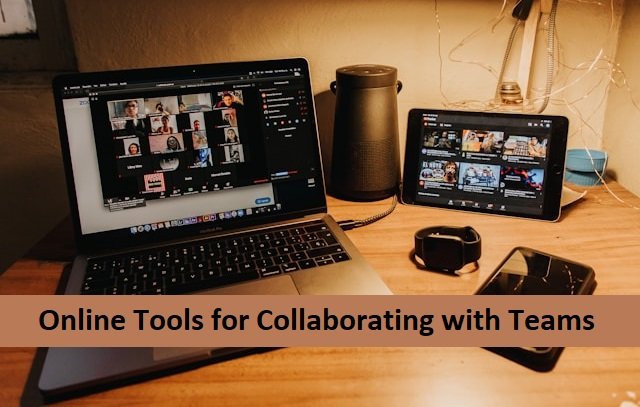
Effective collaboration tools are essential for team productivity and seamless communication in today’s increasingly digital work environment. These tools help teams to work together, regardless of location, enabling real-time collaboration on projects, sharing of resources, and efficient communication. Here are the top five online tools for collaborating with teams:
1. Slack

Overview
Slack is a popular messaging platform designed for team collaboration. It provides a centralized space for communication, integrating with various tools and services, making it easier to manage conversations and workflows.
Key Features
- Channels: Organize conversations by creating channels for different projects, teams, or topics.
- Direct Messaging: Send private messages to team members.
- Integrations: Connect with over 2,000 apps, including Google Drive, Trello, and Zoom.
- File Sharing: Easily share files and documents within channels and direct messages.
- Search Functionality: Quickly find past messages, files, and conversations.
Pros
- User-friendly interface
- Extensive integration options
- Efficient search capabilities
Cons
- Can be overwhelming with too many channels
- Free version has limited message history
Ideal For
Teams of all sizes looking for a versatile communication tool to streamline their collaboration.
2. Microsoft Teams

Overview
Microsoft Teams is a collaboration platform that combines chat, video meetings, file storage, and application integration. It is part of the Microsoft 365 suite, making it a powerful tool for organizations already using Microsoft products.
Key Features
- Chat and Channels: Communicate through group chats and dedicated channels.
- Video Conferencing: Host video meetings with up to 10,000 participants.
- File Sharing and Collaboration: Integrate with OneDrive and SharePoint for file sharing and collaborative editing.
- App Integrations: Access a wide range of third-party and Microsoft 365 apps.
- Security and Compliance: Robust security features and compliance standards.
Pros
- Seamless integration with Microsoft 365
- Comprehensive communication and collaboration features
- High-level security
Cons
- Can be complex to set up and navigate
- Requires a Microsoft 365 subscription for full functionality
Ideal For
Organizations heavily invested in the Microsoft ecosystem looking for a comprehensive collaboration solution.
3. Trello

Overview
Trello is a visual project management tool that uses boards, lists, and cards to help teams organize and prioritize their work. It’s known for its simplicity and flexibility, making it suitable for a wide range of project types.
Key Features
- Boards and Cards: Create boards for projects and use cards to represent tasks.
- Lists: Organize cards into lists that can represent different stages of a project.
- Power-Ups: Enhance boards with additional features and integrations.
- Collaborative Editing: Multiple team members can edit and comment on cards in real-time.
- Checklists and Due Dates: Add checklists, due dates, and attachments to cards.
Pros
- Intuitive and easy to use
- Highly customizable
- Free version offers robust features
Cons
- May lack advanced project management features
- Can become cluttered with large projects
Ideal For
Small to medium-sized teams looking for a simple and flexible project management tool.
4. Asana

Overview
Asana is a powerful project management tool designed to help teams organize, track, and manage their work. It offers a range of features to support various workflows and project management methodologies.
Key Features
- Task Management: Create and assign tasks, set deadlines, and track progress.
- Projects and Workspaces: Organize tasks into projects and workspaces for better visibility.
- Timeline and Calendar Views: Visualize project timelines and task deadlines.
- Integrations: Connect with numerous apps like Slack, Google Drive, and Microsoft Teams.
- Automation: Automate repetitive tasks and workflows.
Pros
- Robust task and project management features
- Highly customizable workflows
- Strong integration options
Cons
- Can be overwhelming for new users
- Higher cost for premium features
Ideal For
Medium to large-sized teams needing a robust project management tool with advanced features.
5. Zoom
Overview
Zoom is a leading video conferencing tool that enables teams to conduct virtual meetings, webinars, and conferences. It’s known for its reliability and ease of use, making it a go-to choice for remote communication.
Key Features
- Video and Audio Meetings: Host HD video and audio meetings with up to 1,000 participants.
- Screen Sharing: Share screens and collaborate in real-time.
- Breakout Rooms: Split meetings into smaller groups for focused discussions.
- Recording and Transcripts: Record meetings and generate transcripts for future reference.
- Webinars and Events: Host large-scale webinars and virtual events.
Pros
- High-quality video and audio
- User-friendly interface
- Versatile features for various meeting types
Cons
- Security concerns in the past
- Free version has time limits for group meetings
Ideal For
Teams of all sizes looking for a reliable video conferencing solution.
FAQs
1. What is the primary function of Slack?
Slack is a messaging platform designed for team collaboration, offering features such as channels, direct messaging, file sharing, and extensive app integrations.
2. How does Microsoft Teams integrate with other Microsoft 365 applications?
Microsoft Teams seamlessly integrates with other Microsoft 365 applications like Outlook, OneDrive, SharePoint, and Office apps, allowing for collaborative editing, file sharing, and streamlined workflows.
3. Can Trello be used for complex project management?
While Trello is known for its simplicity and flexibility, it may lack some advanced project management features required for complex projects. However, its Power-Ups can extend functionality to some extent.
4. What are the key differences between Asana and Trello?
Asana offers more robust project management features, including task dependencies, timeline views, and advanced reporting. Trello, on the other hand, is more visually oriented and easier to use, making it suitable for simpler projects.
5. Is Zoom secure for business meetings?
Zoom has implemented various security measures to address past concerns, including end-to-end encryption, waiting rooms, and stronger authentication methods. It is now considered secure for business meetings when used with proper security settings.
6. Are there any free versions available for these collaboration tools?
Yes, all five tools offer free versions with limited features:
- Slack: Limited message history and integrations.
- Microsoft Teams: Free version with limited features; more functionality available with Microsoft 365 subscription.
- Trello: Free version with basic features and limited Power-Ups.
- Asana: Free version with limited project and task management features.
- Zoom: Free version with 40-minute limit on group meetings.
7. Which tool is best for small teams with limited budgets?
Trello and Slack are excellent choices for small teams with limited budgets, as their free versions provide ample functionality for basic project management and communication.
8. How do these tools handle file sharing and storage?
- Slack: File sharing within channels and direct messages; integrates with cloud storage services like Google Drive and OneDrive.
- Microsoft Teams: Integrates with OneDrive and SharePoint for file storage and sharing.
- Trello: Attach files to cards; integrates with cloud storage services like Google Drive and Dropbox.
- Asana: Attach files to tasks and projects; integrates with various cloud storage services.
- Zoom: Share files during meetings and webinars; integrates with cloud storage services for storing recordings.
9. Can these tools be used across different devices and platforms?
Yes, all five tools are designed to be cross-platform, with apps available for Windows, macOS, iOS, and Android. They also offer web-based versions for access from any device with an internet connection.
10. How do these tools support remote work?
These tools provide features that enhance remote work by enabling real-time communication, virtual meetings, collaborative editing, task management, and file sharing, ensuring that teams can stay connected and productive regardless of location.
Conclusion
Choosing the right collaboration tool depends on your team’s specific needs and workflows. Whether you need a powerful project management tool like Asana, a versatile communication platform like Slack, or a reliable video conferencing solution like Zoom, there are plenty of options to enhance your team’s productivity and collaboration. Evaluate the features, pros, and cons of each tool to determine which one best fits your team’s requirements.





